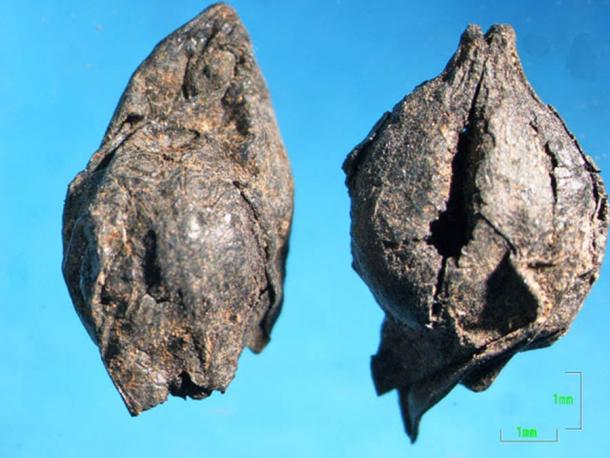
Oldest Wine in Europe Found at Prehistoric Greek Site
Archaeologists undertaking excavations at the prehistoric settlement of Dikili Tash in northern Greece have completed analyses of wine samples from ancient ceramics revealing evidence of wine dating back to 4200 BC. These are believed to be the oldest known traces of wine in Europe!
The Site of Dikili Tash
Dikili Tash is situated 1.2 miles (1.93 km) from the ancient city of Philippi and has been inhabited since 6500 BC. The site is a tell, a massive human-created mound of earth which looms some 49 ft. (15 meters) above the current ground level over an area of 11 acres, the result of millennia of human building and rebuilding in the same place. Archaeological deposits in the tell extend below the current ground surface, for a total of 55 ft. (17 meters) of human occupation.

Caius Vibius Quartus Monument near the village of Krinides and the prehistoric tell Dikili Tash. (Schuppi/CC BY-SA 4.0) Samples taken from ceramics found at Dikili Tash are believed to be evidence of the oldest wine in Europe.
Dikili Tash has been known as an important Neolithic site for over a century, but it was only during recent rounds of excavations at the site that the lowest levels (Early and Middle Neolithic) were identified. Not much is known about people who lived at Dikili Tash during these periods as of yet so the latest finding offers some insight into these ancient people, although the societal changes that may have been influenced by the consumption of alcohol is an issue of debate.
- Quaffing Here For 11 Centuries: Sean’s Bar Claims Title of Oldest Pub in Ireland, Europe and Possibly the World
- Feeling Guilty About Drinking? Well, Ask the Saints
The Oldest Wine in Europe
One example of evidence for wine consumption at Dikili Tash comes in the form of thousands of grape pips and grape marc in the remains of just one house at the site. According to The Archaeology News Network, “the new wine was being prepared in a large jar inside the house, while the juice together with the marc were being fermented.” But then a fire broke out sometime around 4300 BC, destroying the house but preserving the archaeobotanical remains for more than 6,000 years.

Thousands of grape pips and grape marc were found in a house in Dikili Tash, near ancient Philippi. (AMNA/Sultana-Maria Valamoti)
"The find is highly significant for the European prehistory, because it is for the moment the oldest indication for vinification in Europe," said Dimitra Malamidou, co-director of excavations in 2013. "The historical meaning of our discovery is important for the Aegean and the European prehistory, as it gives evidence of early developments of the agricultural and diet practices, affecting social processes."
Discussing the discoveries at Dikili Tash, Sultana-Maria Valamoti, a professor of Prehistoric Archaeology, director of the Laboratory for Interdisciplinary Research in Archaeology / EDAE and the PlantCult Laboratory at the Center for Interdisciplinary Research and Innovation of the AUTH, said, “Thanks to the work done at the Aristotle University of Thessaloniki [AUTH], this data, often neglected by research, provides a wealth of information on the social and economic organization in northern Greece, the daily activities of people, their farming and agricultural practices, as well as specific symbolic activities from the 7th to the 1st millennium BC.”

Archaeological Museum of Philippi, Greece: Black-on-red decorated vessel from Dikili Tash, Late Neolithic II (4800-4200 BC). (Schuppi/CC BY-SA 4.0)
It is believed that the wine traces in Dikili Tash represent the oldest known traces of wine drinking in Europe. Other studies have unearthed a 6,100-year-old Armenian winery and a 6,000-year-old wine sample from Sicily. Beyond Europe, scientists have also found traces of a 9,000-year-old Chinese alcohol made from rice, honey, and fruit.
- Commandaria: The Oldest Wine in Production, Praised By Homer, and Richard the Lionheart's "King of Wines"
- To Open or Not to Open The 1,650-Year-Old Speyer Wine Bottle?
Part of the PlantCult Program
The story of the wine remains at Dikili Tash was just one of the topics covered at a recent event titled “The research work at the Department of History and Archaeology of the Aristotle University of Thessaloniki.” Another interesting discovery mentioned at the event was 4,000-year-old oatmeal which was found in Mesimeriani Toumba (Trilofo) in Thessaloniki. This provided some information on Neolithic cereal cooking in Greece.
Both of these research findings were made possible thanks to the PlantCult program which studies archaeobotany across Europe. The PlantCult team includes researchers at AUTH as well as other Greek universities and other institutions in Europe. They study ancient plant remains, kitchen utensils, and grinding tools then combine this information with ethnographic, experimental, and literary research to gain a better understanding of ancient cuisine and plant ingredients used in Europe. You can find out more about their research here.
Top Image: The oldest evidence of wine in Europe comes from a sample discovered at Dikili Tash in Greece. Source: Daria Minaeva /Adobe Stock
Updated on June 22, 2021.















